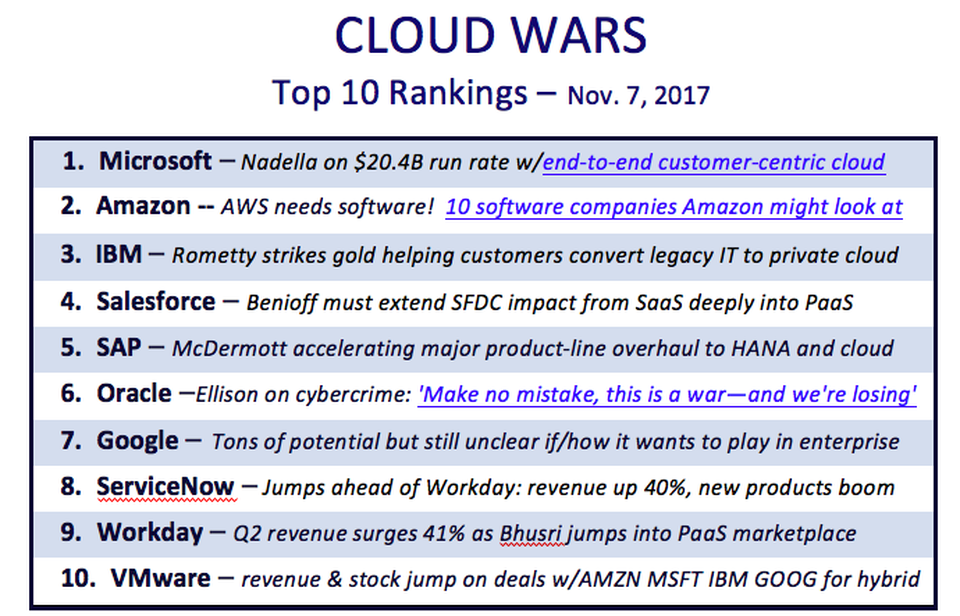Top 6 Biggest Cloud Computing Providers
There is a huge increase in sales in recent years in Cloud Computing. A trend more than consolidated. Let’s see here the 6 biggest suppliers and their strategies around the IaaS, PaaS or SaaS domains. Who is selling more? Combined strategies in one domain or multiple?
(1) Microsoft is the leader in this market today. With the purchase of LinkedIn, Amazon was surpassed. The Azure platform has been very successful with an architecture designed to create, deploy and manage different applications and services through a huge network of data centers managed by Microsoft. In addition, there is an use AI for better management and knowledge of managed instances deployed in its platforms. Azure is a IaaS-centric, but Microsoft also has a good share of revenue in SaaS. With the acquisition of LinkedIn, use of Office 365 and the great growth of Dynamics 365, your position is also guaranteed in SaaS. Dynamics, which encompasses the disciplines of CRM and ERP, has used Microsoft’s installed base to leverage its growth (67% in 2017).
(2) Amazon comes in second place. However, AWS-Amazon Web Services has the predominance sales in Cloud. That is, unlike Microsoft, Amazon focuses its revenue on IaaS only. Amazon hopes to react to Linux 2. Strategies from companies like Microsoft and Oracle (which also has its own version of Linux) are more focused on “hybrid computing.” Hybrid technology allows enterprises to access the cloud and their own servers on premisses and to switch architecture between the models. Linux 2 is Amazon’s strategy to challenge this hybrid model.
(3) In the third position comes IBM. IBM focuses its position on IaaS with its Bluemix and IBM Cloud products. IBM has also fought in the cloud. IaaS providers may offer lower cost per sale, such as AWS. On the other hand, Oracle as a cloud database specialist can make more sense than IBM’s internal solutions. That’s why IBM proposes an extensive solution model where it can make a difference. The acquisition of Gravitant by IBM last year provided a strong demonstration of IBM’s cloud strategy. Gravitant is a cloud management platform, allowing you to compare the various cloud providers based on cost and performance and thus optimize your cloud infrastructure, whether it is in different providers or in a hybrid configuration.
(4) Then, in fourth place, we have Salesforce. Also unlike Microsoft, it focuses its revenue on only one cloud model, this time on the SaaS. Its solution focused on CRM (Sales, Commerce, Marketing and Service) is of greater revenue in the CRM market (after Oracle and SAP) and historically Salesforce has always invested in Cloud Computing. Gartner said the biggest revenue from enterprise software will be CRM, so there’s room for growth here as well. While the Salesforce dispute is more in CRM, it seeks partnerships with vendors IaaS or PaaS to leverage its platform.
(5) In position 5 we have SAP. Again, with revenue focused on one model, SaaS, with its Ariba, SucessFactors, Concur, Hybris and Business ByDesign solutions. SAP focuses its efforts on fighting Oracle and Salesforce, but wants to grow in IaaS, and build partnerships with Microsoft to leverage its products via Azure.
(6) Sixth comes Oracle. It has more revenue in SaaS solutions, notably ERP, HCM, CX and Netsuite. However, it has had good leverage from the Cloud Database, in the PaaS model (which can also provide IaaS models). Oracle has a fast-growing cloud business that focuses on customer needs. Oracle also focuses on automation not only on databases, but on all other cloud platforms, making its PaaS offerings standalone, self-assured, and self-healing.

These 6 vendors dominate about 50% of the global cloud computing market (revenues in 2017). Important to accompany them to understand who can challenge leaders and come first in the coming years. What do you think?